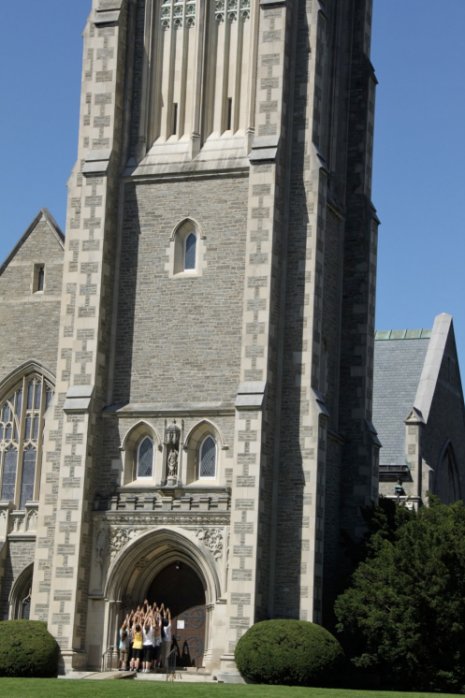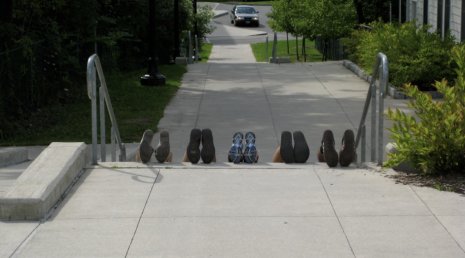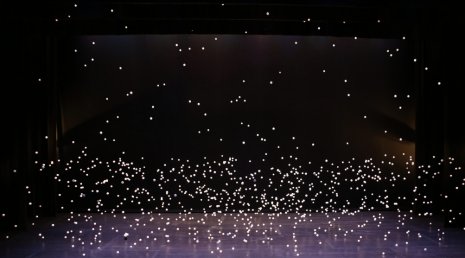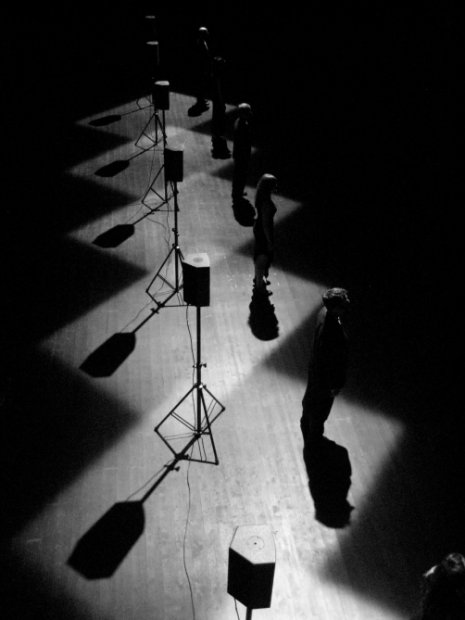Chapter Two
Love this topic… ‘Facts’ in the Space…
A ‘fact-driven’ event is physical -- someone jumps, a group of people move in slow motion, someone juggles five balls, someone performs a somersault, etc. ‘Fact-driven’ events are not performed as a character, but by the performer as him or herself. A traditional actor might build a performance based on given circumstances and inner history, whereas a ‘fact-driven’ performer builds a performance based on what is present and happening here and now. Philosophically speaking, ‘fact-driven’ events exist free from any opinion, mediation or interpretation. ‘Facts’ exist as phenomena in addition to being events. For example, they can be elements present in the space -- the reality of a shop door, the shape and size of the proscenium, a performer’s limp, the position of a window, the squeak of a certain door, the placement of a chair, a line of trees, the way someone walks, a sidewalk, etc. I build performances from the arrangement, juxtaposition, and collision of these ‘facts.’
The first step in the rehearsal process is getting everyone in the room to notice, to sensitize and to work with the elements/facts. This is how I forge an ensemble, using Viewpoints as my tool. Viewpoints enables the ensemble to perceive temporal and spatial information. I’m not at all interested in Viewpoints as a way to spice up a piece of theater (stick some Viewpoints at the start of the evening and then close the performance out with a Viewpoint’s bang). I work with Viewpoints not to add pizzazz but to awaken the consciousness of the performers. A fine-tuning of the entire ensemble begins to take place in their consciousness, in their sensitivity and ability to listen. A mutual, deep, unforced concentration happens -- by performers, by those watching rehearsal and later by audience. It’s way cool.
Looking with an uncluttered eye is (in my humble opinion) the most difficult part of directing. I have a big dilemma with theater. I’m always looking at both the make believe and the actual phenomena. This dilemma occupies much of my thinking about theater. Take black curtains for instance. They hang in most theaters masking things like lights and prop tables backstage. Most of the time the ‘facts’ of the curtains aren’t given a second thought. An actor might finish a scene and make an exit behind one of those black curtains. We (the audience) are used to that – so is the ‘normal/traditional’ theater director. Me? Drives me nuts. That we stop seeing those curtains is a huge problem. Theatrical habits have wiped out the ‘fact’ of the black curtain, its phenomena, what it actually is has disappeared. I actually feel bad for the curtain. We don’t allow it to be a curtain.
During the first half of the rehearsal process, we explore ‘facts’ to research and build compelling fragments. Late in the process, fragments are assembled and, via juxtaposition, a meaning emerges. A rigorous, visual poetry is built. Working this way is messy, often horribly so. We have no idea where we’re going but we’re going there. The art comes from recognizing which ‘fragments’ brush against each other in provocative, unusual ways. Sooner or later, gems emerge. Let me compare my process to a coloring book. When you’re a kid with a coloring book, you open your crayons and pick the one you want to use and you start to carefully color within the lines. I like to work the other way around. Start with the crayons and just see what colors they produce. Then discover the lines that go around those colors. I love it. Plan B (2003) was built this way. More or Less, Infinity (2005), to whom it may concern (1996), SITSTANDWALKLIEDOWN (2010), The Hour We Knew Nothing of Each Other (1999, 2000, 2015, 2019) were all built this way. Sometimes I had stronger hunches about the starting points, but all the projects relied on an ensemble, ‘facts’ and fragments.
Regarding the audience: I invite them into a creative, maybe unfamiliar relationship to the performance. The ensemble and I have put our shoulders into making something. We know precisely what the performance does and now we need the audience to create what the performance means. We leave the door wide open for their interaction; the spectator’s connections are required to make the experience into a whole. All theater leaves room for an audience to imagine but I want to offer them a more symbiotic role, something they can’t help being curious about.
Last question first. I have a bullhorn and yell “Follow me!” Seriously. The audience loves it. They have a grand old time. Plus I have performers doing actions – folding up in child’s pose, standing on railings in business suits – like markers on a path leading the crowd. I call it painting and drawing on the space, kind of a pointillist brush dab. My bullhorn and curiosity help lead the audience to the next event.
I don’t really have any idea what I’m going to do when I start rehearsing. I just walk through the space or spaces, and say to myself ”Wouldn’t it be cool if..…?” (fill in the blank) Like a long sidewalk for instance -- wouldn’t it be cool if I could get a line of people (in business suits of course) to stand evenly spaced on the sidewalk? And that line of people would stretch out for nearly a ¼ mile?
Minimalism does a fantastic thing. The minimalist gesture itself isn’t so interesting – like a crowd of people standing in a line -- but life colliding with that gesture is. People just going about their business collide with the ‘art’ of the people in business suits. That collision is what makes SITSTANDWALKLIEDOWN pop. The rituals of performance mix with the rituals of everyday life.
The piece is designed to function like a tour bus. On the bus, you drive around and the guide says, “Look at this, look at that.” The sites and architecture awaken. The same deal here. I want to wake up the public space by taking deliberately simple gestures and using them as pointers to the space itself. The events of the performance (sitting, standing, walking, lying down) are simple enough to do. In fact, those four gestures derive from daily life; we do them most of the time all day long. The hard part is doing them in unison or in canon as a group. Forging an ensemble with people you’ve never met from all walks of life brings out something large. Ensemble-building is foundational in my work -- performers working together, creating community in order to make an ‘art’ experience for an audience…and for themselves.
I’ve done SITSTANDWALKLIEDOWN several times now. And frankly it hasn’t worn out its welcome. Meaning, I’d do the project again and again. I really wanted to build this project at my mother’s retirement community but management never returned my call. I look at public space as a set that’s already been built. And the set budget was several million dollars! Great. We have so many public spaces left to create with. I love the idea of turning the tables -- doing something you’re not supposed to do where you’re not supposed to do it. It’s subversive and in my humble opinion -- necessary.
I think being a Jack or Jill of all trades can teach you a lot as an artist, especially in the early years. Doing it all certainly empowers you down the road because you’re able to communicate better with other theater artists. But…it would be a big shame to lose out on (or water down) collaboration.
Personally, I love collaboration and I have a simple rule: work with people who are better at something than I am. I can design lights. I can even design a space. But I’m interested in working with people who help me see something about lights and space that I didn’t even know existed. A genuine/rigorous collaboration, not a soft collaboration. A soft collaboration is you need someone to do the lights, you tell them exactly what to do, they do it—and “VOILA,” it goes on the resume as a collaboration. I don’t think so. Deeper collaboration gets more under the skin and happens when you work with people who do what they do better than you.
Authentic collaboration can be scary/unpredictable and rear its head in surprising ways. When I collaborated with Aurelien Bory and CIE111, a French theater company, we rehearsed in Toulouse, France for many weeks. Unfortunately, I don’t really speak any French and most of the performers didn’t speak a word of English. The result? We had to communicate with gestures and sounds instead of words. Wild elbow flinging, bounding around the space, guttural noises. This worked, most of the time. But on some occasions, what I was trying to communicate and what landed had nothing whatsoever to do with each other. At first I really was panicking. Then I realized: possibilities lived in the mistakes. The performers were showing me things, unintended things, that could (and did) open doors. A kind of collaboration based on misunderstanding emerged and I welcomed and embraced it. When in Rome…do like the French. My anxiety disappeared. One of my friends in France is an acrobat named Pelau. He’s incredible. Crotchety with a wild laugh. He used to do one-arm handstands while smoking a cigar. He also didn’t speak a word of English, other than “awesome,” with an ‘H’ at the beginning. Somehow we were able to communicate via energies. I’m still not really sure what he was talking about but it didn’t matter. We were operating via our misunderstandings. We embraced it and wove that process into the fabric of the performance…misperceptions as the natural state of affairs.
I was about 8. My mother, who was a painter and art teacher, brought me to see a dress rehearsal of the Norwalk High School production of Brigadoon. I have no idea if the production was any good or not, but I was mesmerized. I was transformed. My parents, children of the depression, were determined that I would become a constitutional lawyer so I didn't really become involved in theater until after college. I needed a job and, at the urging of my girlfriend’s mother, I stumbled into the Sharon Playhouse in Connecticut. I was hired on the spot as the production stage manager for South Pacific having never stage-managed a day in my life. We rehearsed the whole thing in a week. I was very serious about my work. Because of my new-found commitment, when dress rehearsal rolled around, I found myself overwhelmed -- responsibilities, light and sound cues, actors demanding breaks. I suddenly, loudly and sloppily, bawled my eyes out. The producer (who up until this moment had been a rather nasty, demonic man) talked me down from the ledge. What a summer. By the time we did the next show I was an old pro. I knew live experience was my drug of choice.
If the panel resonated with my work it means the experience of my work is communicating successfully. I don’t know what the panel talked about, but the announcement letter Irene sent to me was beautiful, very moving. Thank you.
When I make theater I attempt to create a powerful, live experience for the audience. I organize that experience in a very musical way, more of a visual music. I hope to give people who perform and watch my work an opportunity to be creative participants in a process. Like life it unfolds itself in wonderful, horrible and mysterious ways. I like to say I make theater for anyone, but not everyone. What I mean by that is if you’d rather stay home and watch a ballgame, fine. But, if you decide to come, the performance will be inviting and available to you. And the show doesn’t take an advanced degree to appreciate. I liken the viewer’s experience to strolling in a garden. A garden offers flowers, scents, rocks, grass, insects—and if a garden is well-organized and planted with artistry, it can be a wonderful experience. I don’t ask the garden to mean something other than to be a wonderful garden. The sensory experience of it is its meaning.
I feel the same way about the work I make: the experience is its meaning. I hope people engage the show with their senses and that the performances have images that move you, make you smile, disturb you, even amaze you, full of gentle humor, pathos and danger. My focus is on creating vibrant experiences for an audience. I then ask the audience to make up their own minds about the performance’s meaning. Many times spectators see something that I have no idea is there. That’s okay with me. I’m not after any one correct meaning. “Seeing is forgetting the name of the thing one sees,” wrote Paul Valery.
Connections of all kinds must exist between the expansion of the imagination and access to resources. We all agree that art funding must increase.
That being said, I’m going to bring up a paradox. I don’t think big slick expensive items are necessary to make compelling art. Resources are hard to come by. I’ve learned a lot from having big ideas and implementing them for $1.98. Of course it’s great to have funding but not at the expense of ingenuity. I’m convinced that resisting slickness in stance, style and attitude is the way to go.
Many of my pieces problematize and explore the relationship between people and technology. Who is leading who and how in this strange symbiosis? I prefer to work with Lo-fi tech…cheap, old school stuff. Lo-fi runs counter to mainstream’s better, faster, slicker. I put equipment front and center, no effort to hide emphasizing Lo-fi’s genuine do-it-yourself nature.
My project I/O (2008) created a complex environment from simple technological means – the piece examines human idiosyncrasy in relation to the machine. Collaborating with sound artist Joe Diebes and artistic director Ron Berry, I built I/O in an airplane hanger using six very strange, original couples. I paired six performers on wireless microphones to six human-sized loudspeakers. All physical and vocal communication between the performers occurred through this tech system. We captured vocal gestures and sonic events in real-time, feeding them back to various locations in the space, creating a time-displaced terrain for the performers to navigate. Joe Diebes and I continue working together. I recently staged his experimental opera oyster about ethnomusicologist Alan Lomax, Cantometrics and the IBM 360.
To rehearse my current project THIS/THAT (2020) I emptied out my storage unit stuffed with years of electronic and visual equipment and just started investigating. My collaborator, Steven Wendt, and I turned things on, found out how they worked and then started using the equipment in ways it wasn’t designed to be used. We’re discovering ways to make cameras, projectors, tripods, equipment come to life – cranking knobs, zooming in and out, maneuvering visual and audio feedback loops, dissolving images together and apart.
To return to your question about money and resources and whether they’re necessary for art and theater-making…I’ve developed a whole approach grounded in exercising the imagination rather than requiring money. To that end, I’ve created an organization called The Institute of Useless Activity. Here's the manifesto:
Dear Phil,
I am delighted - officially and in hard-copy – to tell you that you have been selected as the recipient of the 2020 Alpert Award in Theatre. The panelists were Raelle Myrick Hodges, theater director, creative director, 651 Arts, Brooklyn, New York; Johanna McKeon, director, New York; Diane Rodriguez, director, writer, producer, Rodriguez Projects, Los Angeles.
They asked me to convey their thoughts to you:
1) We are committed to discovering what we don’t yet know about something. To that end, we engage in extended research and development. Each rehearsal starts from a blank page (metaphorically speaking). We investigate something--- e.g. an object, process or convention --- without knowing where we are going or where we will end up. We have faith and confidence we will stumble upon something interesting along the way.
2) We’re swimming in technology in our daily lives. Consequently, we use technology to build our work. We don’t, however, use the technology in the way it was intended.
3) We are committed to discovering and using what we call the ‘facts’ in the space. We are not trying to hide the truth of any object, process or space. We acknowledge their truth. And by doing so, we explore the honest transformations possible when we create work by juxtaposing the facts as they are.
4) We avoid slickness by rediscovering the poetry in simple objects.
5) We are interested in creating new forms by combining and juxtaposing familiar forms.
6) We believe in what John Cage calls “purposeful purposelessness.” Our work does not have to be useful politically or socially---just playful and naïve; curious and full of wonder. Useless art is very useful.





